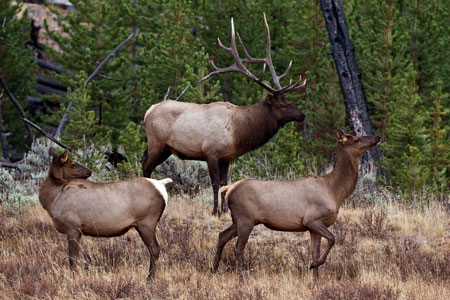

|
Elk (Cervus elaphus) What they look like: Elk, or red deer, range in color from dark brown in winter to tan in summer. They have a characteristic buff colored rump and long thin legs. The head, neck, belly, and legs are darker than the back and sides. Elk generally have a long head with large ears. The adult male, know as a buck, has widely branching antlers as long as 1 to 1.5 m from tip to tip (see photo).
Today large populations of elk in North America are found only in the western United States from Canada through the Eastern Rockies to New Mexico, and in a small region of the northern lower peninsula of Michigan. Elk prefer open woodlands and avoid dense unbroken forests. Elk can be found in coniferous swamps, clear cuts, aspen-hardwood forests, and coniferous-hardwood forests. Elk are widespread in Washington and found in a variety of habitats such as shrub steppe, bunchgrass, shrub plant communities, open meadows near open or closed canopy forests. They move into sub-alpine areas during the summer. Click the range map to learn more about the distribution of Elk in Washington.
What they eat: Elk are browsers. They feed on grasses, sedges, and forbs in summer and woody growth in the winter months. Woody plants include cedar, wintergreen, eastern hemlock, sumac, jack pine, red maple, staghorn, and basswood. Elk are ruminant animals and therefore regurgitate their food and re-chew to aid in digestion. This is also known as chewing cud. Behavior: Males attract females by bugling - a very loud call that can be heard over a distance. Elk are considered pests by many farmers. Over-browsing can cause damage to valued trees and agricultural crops. Reproduction: Bull elk lose the velvet on their antler shortly before the fall rut, in late September and early October. During the rut, they begin to compete for access to females. Dominant males are able to build larger harems of females and restrict access to them by other males. They defend a kind of "moving territory" around the harem. Males advertise this territory, their status, and attract females through bugling. Fights between dominant males and intruders can be intense - sometimes resulting in injury. The seasonal harems usually consist of 1 bull and 6 females plus their yearling calves. A female will give birth to 1 calf. The gestation is about 8 months. The young nurse and are weaned in 2 months. Lifespan: Elk can live beyond 20 years. Predation: Natural predators of elk include grizzly bears, gray wolves, American black bears, and mountain lions. Calves may fall victim to bobcats and coyotes.
Did you know?

Elk photo by Natures Pics More information: Cervus elaphus Information - Animal Diversity Web More photos: Elk Photos |
Animal silhouettes available to purchase »
Photos: Natures Pics
Home | About Us | How to Participate | Biodiversity Modules | Projects | Maps | News | Resources